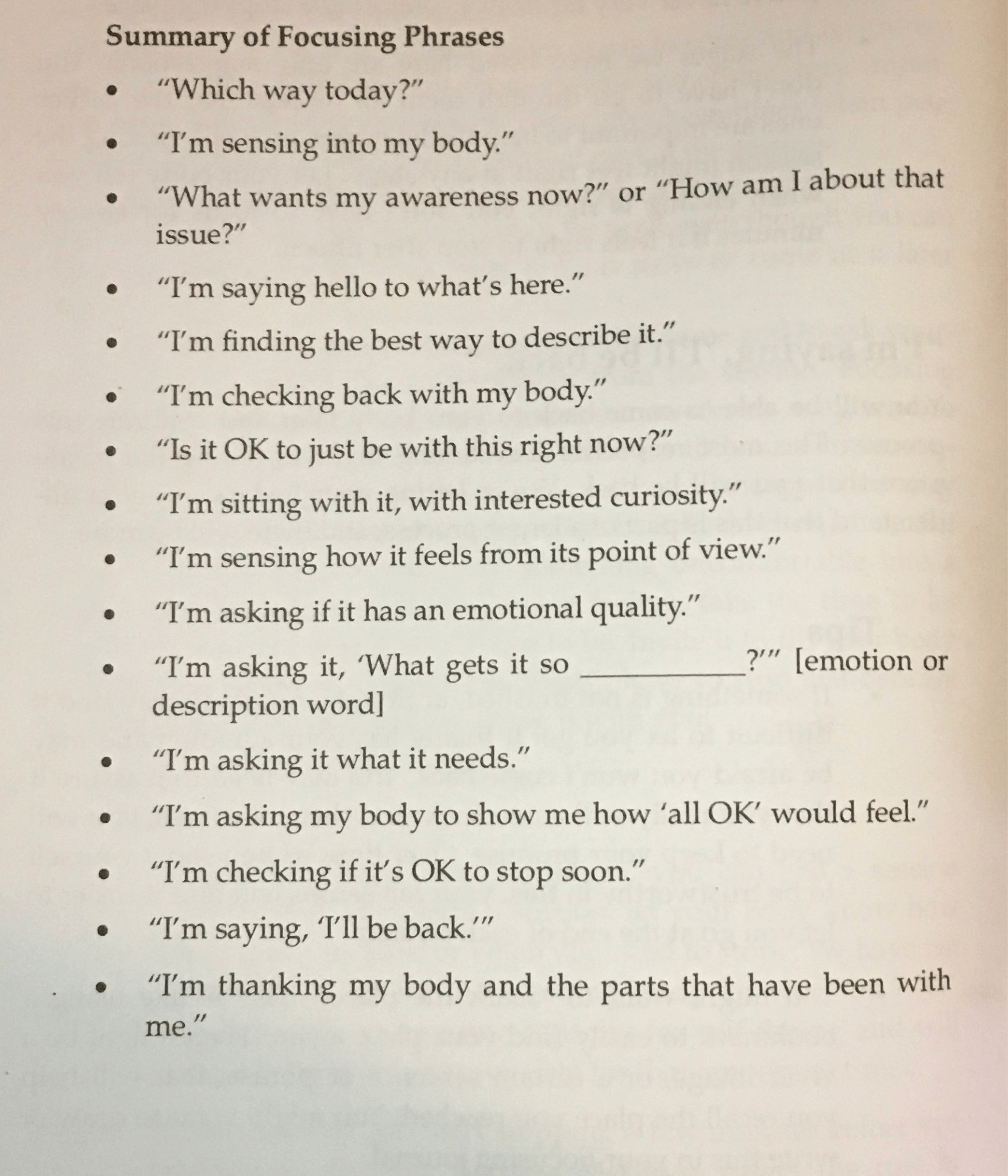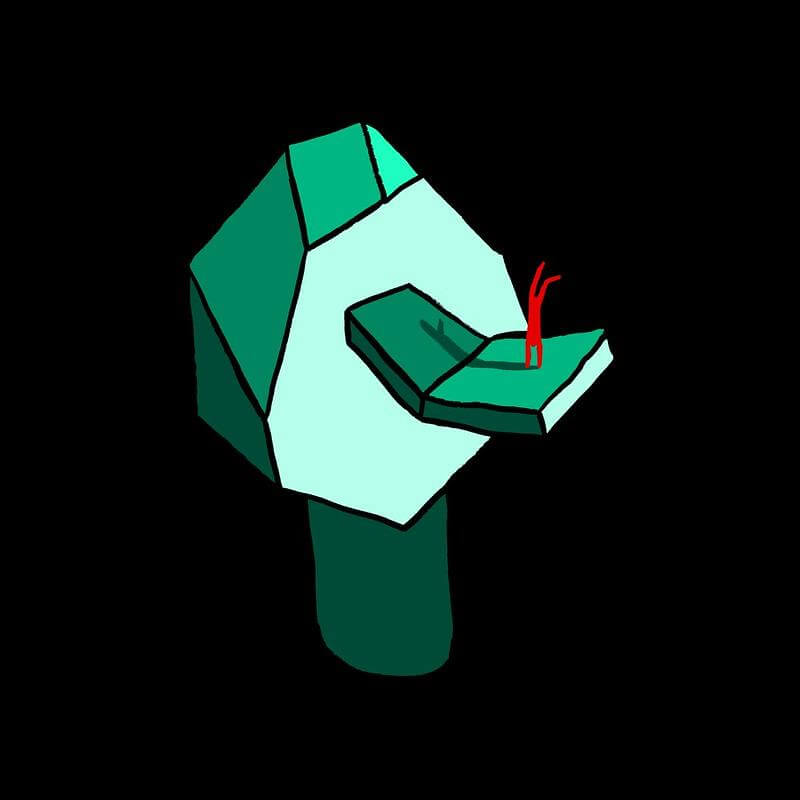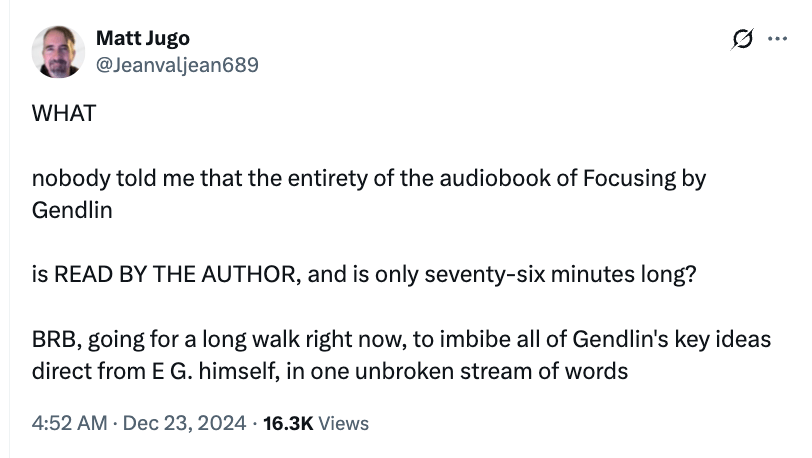Focusing, or Gendlin Focusing, is one of the first self-therapy modalities I encountered. Practicing Focusing helped me to get in touch with my body and its wisdom. My friend Theo describes focusing as a fundamental skill for ‘finding resonance,’ and the general move of finding resonance is core to all somatic imaginal explorations, and even communication.
From the perspective of a parts work modality like Internal Family Systems (IFS), you can see Focusing as a method for getting in touch with parts. Meanwhile, The Bio-Emotive Framework and the NEDERA Technique serves as an expansion pack for Focusing, aimed at emotional processing and resolution.
This is an introductory blog post to Focusing, based on posts by Rival Voices and Vivid Void.

The history of Focusing, according to Rival Voices
Picture this guy narrating the following section:

This dude, Eugene Gendlin, was studying under Carl Rogers, right? And he got 150 hours of therapy on tape and analysed ALL of them. And he crossed them with patient outcomes.
These hours of tape had different clinical psychologists intervening and different methods and so on. But what he figured out is that what reliably predicted improvements in psychotherapy was if people went ‘uh…’ in their sessions.
What reliably predicted improvement in psychotherapy was if people went ‘uh…’ in their sessions.
Imagine yourself in that situation, or anyone sane, immediately dismissing that finding as noise, or not even noticing in the same place.
But Gendlin wasn’t sane, which is why he won.
He also didn’t stop there, because he’s a philosopher first. He understood that people were looking directly into the space where words come from. That there is this pre-verbal meaning that people can access directly. And the proof that it exists is pretty simple. It’s why I can ask you to explain something with other words and you can “go in” inside yourself and come back with different words. This is because the words represent the meaning but the meaning is first and foremost bodily and viscerally felt. Words are just plastered over it, for self or other communication.
Or, a different example, if that one didn’t land: recall seeing someone you know, and you know you know, but whose name you don’t recall. If someone else or yourself gives you wrong guesses, you feel first that they don’t fit with your sense of their name. But when you find the right word, the word that perfectly captures the sense you have (Jane!), you feel this release.
Same is true in therapy, when it goes well. You try to speak directly from your bodily felt meaning about a situation. You circle around it. Eventually you find the words that precisely capture it – release! A felt shift has happened.
Focusing is nothing but a set of instructions for getting to and speaking from this level of felt meaning.
You can use it to write—and you can’t write poetry without it, and if you do write poetry you already use it—to speak—Jordan Peterson evidently uses it all the time—, to theorise, to clarify to yourself what you actually think, for anything really.
What this man found was revolutionary and the world hasn’t yet come to grips with it. But it will.
P.S. If you want to hear Rival’s story of encountering Focusing and how it shaped his relationship to writing and posting on Twitter, you can listen to our podcast conversation, Posting and Vibing with Rival Voices (Video / Audio), esp. starting at ~9:30.
How to Do Gendlin Focusing
or, Gendlin Focusing Instructions (by Vivid Void)

Focusing is a basic form of insight meditation – a way of gently listening to the body without judgment or assumptions. It helps to develop inner awareness and to get you in touch with your body’s natural wisdom. It also helps to transform and synthesize experiences you have had that are stored in the body.
Feelings can not be changed with the mind, and they will not go away over time. If they are not fully felt and allowed to run their full course, they will remain static in the body, and may eventually become unhealthy.
Focusing is a way of uncovering and feeling feelings that are locked in the body, allowing one to come into full presence with themselves, and to develop a deeper, trusting relationship with their somatic aspects of experience.
The Focusing Process
- Begin focusing as you would any other meditation. Find a comfortable place to sit, and take a few moments to settle in, in a relaxed, alert position.
- In your journal, write down anything weighing on your mind that feels anxious or pressing that might interfere with the session.
- Tell your body how much time you have to sit with it. For example, “I have ten minutes for focusing today.”
- Assume the qualities of a good listener:
- Welcoming
- Holding space
- Hearing the essence
- Staying in the present
- Accepting – don’t try to change what you are hearing
- Ask the body, “Where shall I place my attention today?” or “Which way should I go?” If nothing is forthcoming, place your awareness in each of the following areas of your body, holding space for a felt sensation to arise:
- Upper torso
- Stomach and abdomen
- Hips, genitals, posterior
- Legs and feet
- Throat
- Face
- When a felt sensation arises, communicate with it in stages.
- Say “hello” to the sensation
- Try to describe it
- Ask the body if your description is correct
- Ask if it’s okay to just sit with the feeling, with interested curiosity
- Sense how it feels from its point of view
- Ask if it has an emotional quality
- If yes, ask what makes it (emotion or descriptive word?)
- Ask your body what it needs
- Ask your body to show you what “all okay” would feel like
- When it is time to wind down the focusing session:
- Check with your body and ask if it’s okay to stop soon
- Promise that you will be back
- Express gratitude for spending time with you
- In your journal, write down:
- Any general reflections you have on the session
- Interesting sensations
- Any changes, especially dramatic positive feelings of change, which should be “grounded” in the journal after they are processed
- If something wasn’t finished processing, “mark the place” so you can return to it
Here are some tips:
- If nothing is happening, slow down. The process often takes time.
- Approach sensations as though they were animals on the edge of the forest. If you try to force them or control them, they will run away.
- Don’t use the word “why?” That word belongs to the mind. Use “what” or “how.”
- Give yourself “stopping room.” Ask if it’s okay to stop soon with enough time that your body feels honored. A good rule of thumb is to give two minutes of stopping room for each ten minutes in focusing.
- Treasure good feelings – sit and enjoy them as long as they are there. They are important for living well and aid in physical healing processes.
- If you can’t feel anything negative, try searching for positive feelings – spaciousness or relaxation.
- Feel into censorship feelings – the feelings of blocking or judging other, deeper feelings. Give them the full, nonjudgmental process.
- Learn to recognize and honor both the Inner Critic and the Inner Doubter. Ask them what they need, what they want, how you can help them
I also love this checklist from The Power of Focusing (Amazon / Archive.org) by Anne Weiser Cornell:

Each of these phrases or questions may be sufficiently suggestive on its own, but has a specific meaning that is expanded in her book.
Conclusion

May the practice of Focusing bring you towards deeper intimacy with your own experience. May you delight in understanding yourself, and may your self-knowledge benefit all beings. ❤️
Further Resources
- The Power of Focusing by Anne Weiser Cornell (also available for free on the Internet Archive)
- Ann Weiser Cornell’s website
- The Focusing Student’s & Companion’s Manual, Part One and Part Two
- Focusing by Eugene T. Gendlin
- The International Focusing Institute
- The Classic Six Step Focusing Procedure: Gendlin’s six steps and instructions for not following instructions
- The IFI YouTube channel, which includes a lot of guided Focusing exercises
- Events
- The British Focusing Association
- Alex’s Focusing Diagram
- The Living Process with Greg Madison: a podcast about Focusing and related ideas (YouTube / Spotify)
Thank you to Rich Bartlett for prompting the creation of this post, and to Rival Voices and Vivid Void for their permission to remix their work into this post. Thank you to Alex, Theo, and Agi for reviewing this post and providing feedback.
The art in this post was created by Sílvia Bastos, and is licensed under a CC BY 2.0 license. You can support her work on Patreon.

